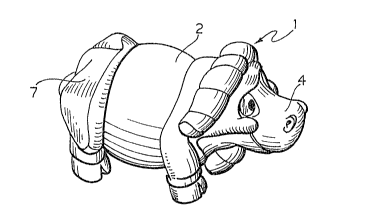Une partie des informations de ce site Web a été fournie par des sources externes. Le gouvernement du Canada n'assume aucune responsabilité concernant la précision, l'actualité ou la fiabilité des informations fournies par les sources externes. Les utilisateurs qui désirent employer cette information devraient consulter directement la source des informations. Le contenu fourni par les sources externes n'est pas assujetti aux exigences sur les langues officielles, la protection des renseignements personnels et l'accessibilité.
L'apparition de différences dans le texte et l'image des Revendications et de l'Abrégé dépend du moment auquel le document est publié. Les textes des Revendications et de l'Abrégé sont affichés :
| (12) Brevet: | (11) CA 2081151 |
|---|---|
| (54) Titre français: | JOUET ARTICULE AYANT GENERALEMENT LA FORME D'UN ANIMAL OU D'UNE POUPEE |
| (54) Titre anglais: | JOINTED PLAYTHING, FOR EXAMPLE IN THE FORM OF A SMALL ANIMAL OR DOLL |
| Statut: | Réputé périmé |
| (51) Classification internationale des brevets (CIB): |
|
|---|---|
| (72) Inventeurs : |
|
| (73) Titulaires : |
|
| (71) Demandeurs : | |
| (74) Agent: | MACRAE & CO. |
| (74) Co-agent: | |
| (45) Délivré: | 1998-10-27 |
| (22) Date de dépôt: | 1992-10-22 |
| (41) Mise à la disponibilité du public: | 1993-05-01 |
| Requête d'examen: | 1995-02-08 |
| Licence disponible: | S.O. |
| (25) Langue des documents déposés: | Anglais |
| Traité de coopération en matière de brevets (PCT): | Non |
|---|
| (30) Données de priorité de la demande: | ||||||
|---|---|---|---|---|---|---|
|
Jouet pouvant former de petits animaux ou des poupées, comprenant essentiellement un corps principal (2) de forme sphérique et deux corps auxiliaires (4, 7) qui reproduisent des parties anthropomorphes et/ou zoomorphiques et comportent des surfaces de coupelle internes (6, 9) qui s'accouplent en coulissant avec le corps principal (2). Les deux corps auxiliaires (4,7) sont munis d'éléments complémentaires (10 à 15) définissant un joint à rotule dont le centre (P) est essentiellement confondu avec le centre de la surface sphérique du corps principal (2).
The plaything, which lends itself to the formation of
small animals or dolls, comprises essentially a main body
(2) of spherical shape and two auxiliary bodies (4, 7)
which reproduce anthropomorphic and/or zoomorphic parts
and which have respective internal cup surfaces (6, 9)
slidingly coupled with the main body (2). The two
auxiliary bodies (4, 7) carry complementary elements (10
to 15) together defining a ball joint whose ball centre
(P) is substantially coincident with the centre of the
spherical surface of the main body (2).
Note : Les revendications sont présentées dans la langue officielle dans laquelle elles ont été soumises.
Note : Les descriptions sont présentées dans la langue officielle dans laquelle elles ont été soumises.

Pour une meilleure compréhension de l'état de la demande ou brevet qui figure sur cette page, la rubrique Mise en garde , et les descriptions de Brevet , États administratifs , Taxes périodiques et Historique des paiements devraient être consultées.
| Titre | Date |
|---|---|
| Date de délivrance prévu | 1998-10-27 |
| (22) Dépôt | 1992-10-22 |
| (41) Mise à la disponibilité du public | 1993-05-01 |
| Requête d'examen | 1995-02-08 |
| (45) Délivré | 1998-10-27 |
| Réputé périmé | 2002-10-22 |
Il n'y a pas d'historique d'abandonnement
| Type de taxes | Anniversaire | Échéance | Montant payé | Date payée |
|---|---|---|---|---|
| Le dépôt d'une demande de brevet | 0,00 $ | 1992-10-22 | ||
| Enregistrement de documents | 0,00 $ | 1993-05-11 | ||
| Taxe de maintien en état - Demande - nouvelle loi | 2 | 1994-10-24 | 100,00 $ | 1994-10-05 |
| Taxe de maintien en état - Demande - nouvelle loi | 3 | 1995-10-23 | 100,00 $ | 1995-09-19 |
| Taxe de maintien en état - Demande - nouvelle loi | 4 | 1996-10-22 | 100,00 $ | 1996-09-18 |
| Taxe de maintien en état - Demande - nouvelle loi | 5 | 1997-10-22 | 150,00 $ | 1997-08-28 |
| Taxe finale | 300,00 $ | 1998-06-11 | ||
| Taxe de maintien en état - Demande - nouvelle loi | 6 | 1998-10-22 | 150,00 $ | 1998-09-24 |
| Taxe de maintien en état - brevet - nouvelle loi | 7 | 1999-10-22 | 150,00 $ | 1999-09-15 |
| Taxe de maintien en état - brevet - nouvelle loi | 8 | 2000-10-23 | 150,00 $ | 2000-09-13 |
Les titulaires actuels et antérieures au dossier sont affichés en ordre alphabétique.
| Titulaires actuels au dossier |
|---|
| SOREMARTEC S.A. |
| Titulaires antérieures au dossier |
|---|
| FERRERO, PIETRO |